In bright light and when shooting indoors, the Find X5 Pro delivers vivid, pleasing colors that are close enough to many competitors. Only the rendering of darker skin tones can occasionally be inaccurate, with a pinkish cast or a slightly desaturated appearance. In low-light scenes lit by warm light sources, the Find X5 Pro produces a rather strong orange cast. On the predecessor X3 Pro, the effect is more pronounced, but the iPhone 13 Pro Max does noticeably better, conveying a pleasantly warm feel while maintaining an overall accurate color rendition.
Autofocus
95
Asus smartphone for Snapdragon insiders
Asus smartphone for Snapdragon insiders
Autofocus tests focus on focus accuracy, focus repeatability, shutter lag and depth of field. The shutter lag is the difference between the time the user presses the capture button and the time the image is actually taken. It includes focus speed and the ability of the device to capture images at the right moment, what is called “zero shutter lag” capability. While shallow depth of field can be nice for a single-subject portrait or close-up, it can also be a problem in some specific conditions such as group portraits; Both situations are tested. Focus accuracy is also evaluated in all real-life images taken, from infinity to close-up objects and in low light to outdoor conditions.
Autofocus irregularity and speed: 1000Lux Δ7EV Daylight Handheld
This graph illustrates focus accuracy and speed as well as zero shutter lag capability, showing edge sharpness versus shutter speed measured on the AFHDR setting over a series of images. All photos were taken at 1000 Lux with the Daylight Highlighter, 500ms after blurring. In this scenario, the backlit panels in the scene are set to simulate a fairly high dynamic range: the luminance ratio between the brightest spot and an 18% reflective gray spot is 7, which we denote with an exposure value difference of 7 edge sharpness is measured on the four edges of the Dead Leaves graph and shutter speed is measured on the Universal Timer LED.
The Oppo’s autofocus system generally works effectively, locking the subject in all scenes. However, it can be a bit slow. Unlike many of its Ultra Premium competitors, the Find X5 Pro does not have zero shutter lag, meaning it takes an extra tap to capture the image after the user presses the shutter button. shutter. There is therefore a greater risk of missing the decisive moment in moving scenes.
A slightly shallow depth of field means that subjects in the background tend to be slightly out of focus. In this scene, the X5 Pro produces good sharpness on the closest face, but the model further back is completely blurry. In comparison, the Find X3 Pro offers a wider depth of field, thanks to its slightly smaller lens aperture.
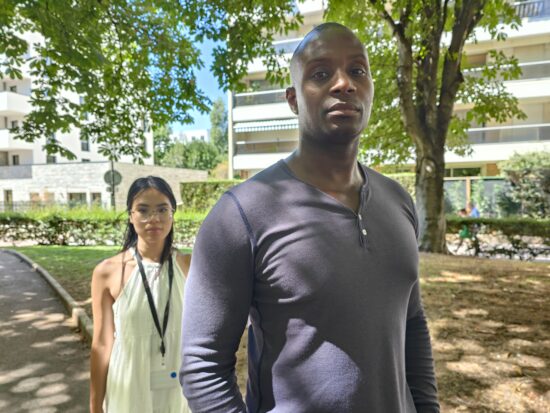
Oppo Find X5 Pro, outdoor scene

Oppo Find X5 Pro: limited depth of field, completely blurred background pattern
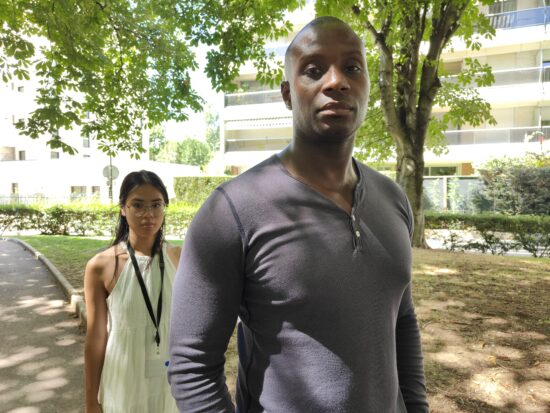
Oppo Find X3 Pro, outdoor scene

Oppo Find X3 Pro: good depth of field, fairly sharp background pattern

Apple iPhone 13 Pro Max, outdoor scene

Apple iPhone 13 Pro Max: Slightly limited depth of field, second model slightly blurry
Structure
102
Xiaomi Mi 11
Xiaomi Mi 11
Texture tests analyze the level of detail and texture of subjects in images taken in the laboratory as well as in real-life scenarios. For natural shots, special attention is paid to the level of detail in the light and dark areas of the image. Objective measurements are performed on map images taken under various lighting conditions from 1 to 1000 lux and different types of dynamic range conditions. The charts used are the proprietary SBMARK (DMC) chart and the Dead Leaves chart.
SBMARK CHART (DMC) detail retention score versus lux levels for tripod and handheld conditions
This graph shows the evolution of the DMC detail retention score with the lux level, for two retention conditions. The DMC detail retention score is derived from an AI-based metric trained to evaluate texture and detail rendering on a selection of crops from our SBMARK chart.
The Oppo Find X5 Pro captures good details in bright light conditions and with typical indoor lighting, but as expected, a loss of detail becomes more noticeable in low light conditions. In our lab tests, the X5 Pro still performs well compared to the iPhone 13 Pro Max, but our measurements also show that the Find X3 Pro retains more detail than the newer model.
Noise
78
Honor Magic4 Ultimate
Honor Magic4 Ultimate
Noise tests analyze various attributes of noise such as intensity, chromaticity, grain, texture on real-life images and graphical images taken in the laboratory. For natural images, special attention is paid to noise on faces, landscapes, but also on dark areas and high dynamic range conditions. Noise on moving objects is also evaluated on natural images. Objective measurements are performed on graphical images taken under various conditions from 1 to 1000 lux and different types of dynamic range conditions. The graph used is the Dead Leaves graph and standardized measurement such as visual noise derived from ISO 15739.
Evolution of visual noise with lighting levels in handheld condition
This graph shows the evolution of the visual noise metric with the lux level under portable conditions. The visual noise metric is the average of the visual noise measurement across all patches of the Dead Leaves chart in the AFHDR setting. SBMARK visual noise measurement is derived from the ISO15739 standard.
Noise is generally well controlled in all conditions, although the laboratory measurements are slightly higher than the predecessor X3 Pro. In comparison, the iPhone measures louder noise at all light levels.
In real-life scenes, noise is well under control on faces but is more noticeable in solid-colored areas, especially in low-light conditions.

Oppo Find X5 Pro, indoor scene

Oppo Find X5 Pro: well-controlled noise on the subject

Oppo Find X3 Pro, indoor scene

Oppo Find X3 Pro: slight luminance noise on the subject

Apple iPhone 13 Pro Max, indoor scene

Apple iPhone 13 Pro Max: Light luminance noise on the subject
Manufactured goods
66
Google Pixel 6
Google Pixel 6
Artifact evaluation examines lens shading, chromatic aberrations, geometric distortion, edge ring, halos, ghosting, quantization, unexpected changes in color tone, among other types of possible unnatural effects on photos. The more severe and frequent the artifact, the greater the point deduction from the score. The main artifacts observed and the corresponding point loss are listed below.
Main penalties for photographic artifacts
Unwanted image artifacts are particularly visible when the camera’s HDR algorithm activates in backlit scenes. In this type of situation, our testers observed artifacts such as color quantization, ringing, haloing, and ghosting.
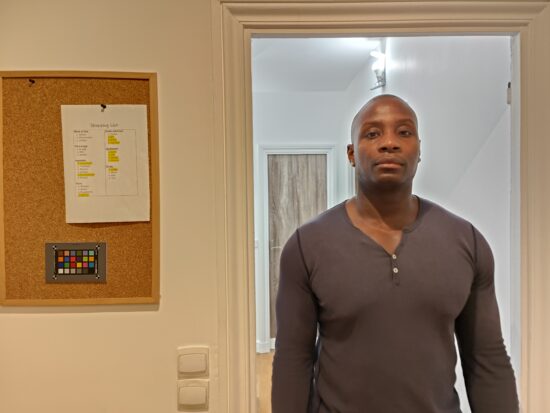
Oppo Find X5 Pro, indoor scene

Oppo Find X5 Pro: HDR artifacts, haloing, ringing, ghosting
Preview
69
Apple iPhone 13 Pro Max
Apple iPhone 13 Pro Max
The preview tests analyze the image quality of the camera app image preview, with particular attention to the difference between capture and preview, especially with regards to dynamic range and application of the bokeh effect. The smoothness of exposure, color and focus adaptation are also evaluated when zooming from the minimum to the maximum available zoom factor. The preview frame rate is measured using the Universal Timer LED.
Find X5 Pro does not apply any HDR processing to the preview image. As a result, what you get in the final capture may look slightly different than what you see in the preview on the device display.
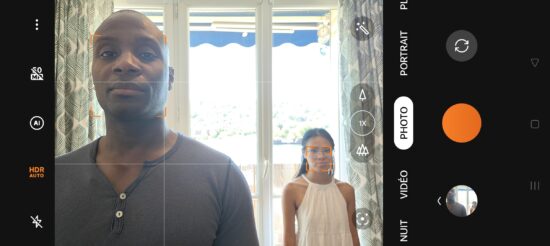
Oppo Find X5 Pro, preview: limited dynamic range

Oppo Find X5 Pro, capture: wide dynamic range
Bokeh
65
Huawei P50 Pro
Huawei P50 Pro
Bokeh is tested in a dedicated mode, usually in portrait or aperture mode, and analyzed by visually inspecting all images captured in the lab and under natural conditions. The goal is to reproduce portrait photography comparable to that taken with a DSLR and a wide aperture. The main image quality attributes to look out for are depth estimation, artifacts, blur gradient, and bokeh blur spotlight shape. The attributes of the portrait image quality (exposure, color, texture) are also taken into account.
In portrait mode, the X5 Pro captures good details on the subject’s face, an improvement over the X3 Pro predecessor. Depth estimation is generally good, but some minor errors may be visible around the foreground subject. By default, the X5 Pro uses the main camera in this mode and the focal length of 27mm isn’t ideal for portraits. You need to get close enough to your subject for a shot that fills the frame, and the wide angle lens can cause a slightly distorted look on faces. However, users have the option to switch to the 2x goal.

Oppo Find X5 Pro: good depth estimate and detail on the face

Oppo Find X3 Pro: good depth estimate but lack of details on the face

Apple iPhone 13 Pro Max: good depth estimate but high noise levels on the face
Enlarge
77
Honor Magic4 Ultimate
Honor Magic4 Ultimate
Learn about SBMARK camera zoom tests
SBMARK engineers capture and evaluate over 400 test images in controlled laboratory environments and in outdoor, indoor and natural scenes in low light conditions, using default camera settings and zooming in at various zoom factors, from ultra wide angle at ultra-long range zoom. Assessment is done by visually inspecting images Cons a natural scene reference and making objective measurements of graphs captured in the lab under different conditions from 20 to 1000 lux and color temperatures from 2300K to 6500K.
For zooming in and out, the Find X5 Pro is a bit of a mixed bag. The ultra wide-angle camera works well, thanks to the good target exposure and nice white balance. The 15mm equivalent focal length is similar to that of competitors in this class and allows you to fit a lot of scene into the frame. The level of detail captured is superior to that of many competitors and a noticeable improvement over the predecessor.
However, to zoom the distance in tele mode, the Find X5 Pro is not the best option. Both white balance and exposure are accurate in telephoto zoom images, but since the Oppo only has a 2x telephoto lens, the level of detail is generally low, especially at medium and long range telephoto settings. Image noise is evident in all shooting conditions. The Find X5 Pro comes with the same 2x tele as its X3 Pro predecessor, but many current competitors in the segment offer longer zoom lenses, for example the iPhone 13 Pro Max with its 3x variant.
Wide
51
Honor Magic4 Ultimate
Honor Magic4 Ultimate
These tests analyze the performance of the ultra-wide-angle camera at different focal lengths from 12mm to 20mm. All attributes of image quality are evaluated, with particular attention to artifacts such as chromatic aberrations, lens softness and distortion. The images below are an excerpt of tested scenes.
The ultra wide angle camera offers a wide field of view and is capable of capturing images with precise exposure and beautiful colors. In addition, the detail is better than the rivals, especially the background of the image. On the downside, the noise is a bit more noticeable in the solid-colored areas.

Oppo Find X5 Pro, ultra wide

Oppo Find X5 Pro: good detail on subject and background, well controlled noise

Oppo Find X3 Pro, ultra wide

Oppo Find X3 Pro: limited details, especially in the background, pink cast of the white balance

Apple iPhone 13 Pro Max, ultra wide

Apple iPhone 13 Pro Max: limited details, noise
Tele
94
Honor Magic4 Ultimate
Honor Magic4 Ultimate
All image quality attributes are evaluated at focal lengths from about 40mm to 300mm, with a focus on texture and detail. The score is derived from a series of objective measurements in the laboratory and from the perceptual analysis of real-life images.
SBMARK CHART (DMC) zoom score for detail retention versus lux levels for tripod and handheld conditions
This graph shows the evolution of the DMC detail retention zoom score with the lux level, for two retention conditions. The DMC detail retention score is derived from an AI-based metric trained to evaluate texture and detail rendering on a selection of crops from our SBMARK chart.
SBMARK CHART (DMC) zoom score for detail retention versus lux lux levels for tripod and handheld conditions
This graph shows the evolution of the DMC detail retention zoom score with the lux level, for two retention conditions. The DMC detail retention score is derived from an AI-based metric trained to evaluate texture and detail rendering on a selection of crops from our SBMARK chart.
SBMARK CHART (DMC) zoom score for detail retention versus lux levels for tripod and handheld conditions
This graph shows the evolution of the DMC detail retention zoom score with the lux level, for two retention conditions. The DMC detail retention score is derived from an AI-based metric trained to evaluate texture and detail rendering on a selection of crops from our SBMARK chart.

Oppo Find X5 Pro, close up telephoto: wide dynamic range, slight loss of detail, slight noise

Oppo Find X3 Pro, close up telephoto: limited dynamic range, slight loss of detail, slight noise

Apple iPhone 13 Pro Max, close up telephoto: wide dynamic range, slight underexposure on the face, loss of detail, noise
In the example above you can see that the X5 Pro generally performs well at close range. Exposure balance between subject and background is better than rivals, but there is a lack of detail on the subject’s face and noise is noticeable too. At close range, both of Oppo’s cameras perform better than the iPhone.
Things go slightly downhill in the medium and long range, however, due to the Oppo’s limited optical zoom capabilities. The lack of detail becomes more noticeable and the dynamic range is also more limited.
video
111
Apple iPhone 13 Pro Max
Apple iPhone 13 Pro Max
About SBMARK Camera Video Tests
SBMARK engineers capture and evaluate over 2.5 hours of video in controlled laboratory environments and natural low-light scenes, indoor and outdoor, using the camera’s default settings. The assessment consists of visually inspecting natural videos taken under various conditions and carrying out objective measurements on graphical videos recorded in the laboratory under different conditions from 1 to 1000 lux and color temperatures from 2300 to 6500K.
The Oppo Find X5 Pro is overall a good choice for mobile VCRs. The video footage is well exposed and offers beautiful colors in most conditions. In bright light and indoors, the details are good and the video noise rather limited. An effective video stabilization system helps minimize camera shake and makes handheld shooting smooth. On the downside, video recordings can sometimes be underexposed in difficult backlit high contrast scenes.
Oppo Find X5 Pro Video vs Ultra-Premium scores
Video tests analyze the same image quality attributes as still images, such as exposure, color, texture, or noise, as well as temporal aspects such as speed, exposure uniformity and stability, white balance, and autofocus transitions.
Exposure
89
Apple iPhone 13 Pro Max
Apple iPhone 13 Pro Max
Exposure tests evaluate the brightness of the main subject and the dynamic range, eg. the ability to make details visible in both light and dark areas of the image. The stability and temporal adaptation of exposure are also analyzed.
In video mode, the X5 Pro generally performs well for exposure in bright light. Target exposure is accurate, and a fairly wide dynamic range ensures good detail in highlights and shadows. Furthermore, the exposure is fairly stable, an improvement over the X3 Find Pro, which tends to adapt exposure to scene changes slowly or unnecessarily.
However, high-contrast scenes, especially backlit scenes, can cause some problems. As in the example below, subjects can be underexposed. For this scene, both comparison devices offer a better overall yield by sacrificing some prominent details in the background and prioritizing subject exposure.

Oppo Find X5 Pro: underexposed subjects, some highlight clipping in the background
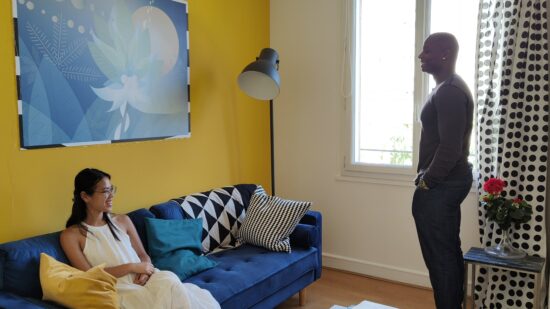
Oppo Find X3 Pro: good subject exposure, strong highlight clipping
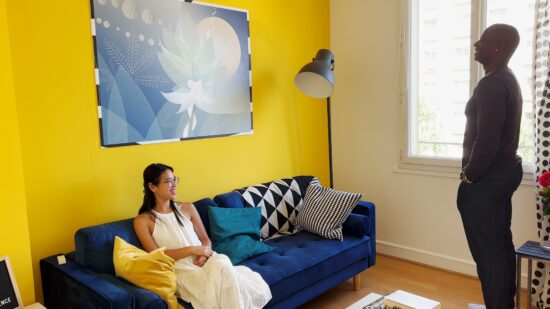
Apple iPhone 13 Pro Max: good exposure of the subject, some clipping of the highlights in the background
Color
98
Honor Magic4 Ultimate
Honor Magic4 Ultimate
Image quality color analysis examines color rendition, skin tone rendition, white balance, color shading, white balance stability and adaptation when the light changes.
When recording video in bright outdoor light or indoor scenes, the X5 Pro produces pleasantly vivid colors with a warm touch. In comparison, the Find X3 Pro is more neutral but both cameras produce good colors.
When shooting in warmer, but still pleasant low-light conditions, the color casts become visible. The overall video color results are similar to the Find X3 Pro but not on the same level as the iPhone, which does a better job of controlling color casts while keeping warm colors well saturated.

Oppo Find X5 Pro: Pleasantly warm white balance

Oppo Find X3 Pro: neutral white balance

Apple iPhone 13 Pro Max: nice white balance
Structure
86
Oppo Reno6 Pro 5G (Snapdragon)
Oppo Reno6 Pro 5G (Snapdragon)
Consistency tests analyze the level of detail and texture of real-life videos, as well as graph videos recorded in the lab. Natural video recordings are evaluated visually, with particular attention to the level of detail in bright areas and dark areas. Objective measurements are performed on images of graphs taken under various conditions from 1 to 1000 lux. The charts used are the SBMARK (DMC) chart and the Dead Leaves chart.
SBMARK CHART (DMC) detail retention video score versus lux levels
This graph shows the evolution of the DMC detail retention video score with the lux level in the video. The DMC detail retention score is derived from an AI-based metric trained to evaluate texture and detail rendering on a selection of crops from our SBMARK chart.
The lab measurements for video detail are lower on the Find X5 Pro than some competitors. This is also evident in real-life internal and external scenes, where details are softer than for example on the iPhone 13 Pro Max. As you would expect, in low light, the levels of detail decrease, but this is also true. for the competition. We also observed a slight loss of detail in difficult high-contrast scenes.

Oppo Find X5 Pro, indoor scene

Oppo Find X5 Pro: soft details

Oppo Find X3 Pro, indoor scene

Oppo Find X3 Pro: good detail but loss of fine detail

Apple iPhone 13 Pro Max, indoor scene

Apple iPhone 13 Pro Max: good detail
Noise
90
Apple iPhone 13 Pro Max
Apple iPhone 13 Pro Max
Noise tests analyze various noise attributes such as intensity, chromaticity, grain, texture, temporal aspects on real-life video recordings and graphing videos taken in the laboratory. Natural videos are evaluated visually, with a focus on noise in dark areas and high dynamic range conditions. Objective measurements are performed on card videos recorded under various conditions from 1 to 1000 lux. The graph used is the SBMARK visual noise graph.
Video noise is generally well under control in bright light and indoors, but becomes more intrusive in low light. In this graph, we can see that the measurements on the X5 Pro and X3 Pro are quite similar, with slightly higher noise levels on the newer device in low light and outdoors. IPhone noise levels are the lowest of all light levels.
Spatial evolution of visual noise with the level of illuminance
This graph shows the evolution of spatial visual noise with the level of lux. Spatial visual noise is measured on the visual noise graph in the video noise setting. SBMARK visual noise measurement is derived from the ISO15739 standard.
Time evolution of visual noise with the level of illuminance
This graph shows the evolution of temporal visual noise with the level of lux. Visual temporal noise is measured on the visual noise graph in the video noise setting.
Stabilization
102
Viva X70 Pro +
Viva X70 Pro +
The stabilization assessment verifies the device’s ability to stabilize footage using software or hardware technologies such as OIS, EIS, or any other means. The assessment examines residual motion, smoothness, yellow artifacts, and residual motion blur in walking and running use cases under various lighting conditions. The video below is an excerpt from one of the tested scenes.
The X5 Pro’s video stabilization is quite effective, making shooting rather smooth, especially when running while recording. Overall performance is on a similar level to the competition in the Ultra Premium segment.
Oppo Find X5 Pro: effective stabilization when walking and running
Oppo Find X3 Pro: effective stabilization when walking and running
Apple iPhone 13 Pro Max: effective stabilization when walking and running
Manufactured goods
81
Xiaomi 12S Ultra
Xiaomi 12S Ultra
Artifacts are evaluated with MTF and ring measurements on the SFR graph in the laboratory, as well as frame rate measurements using the Universal Timer LED. Natural videos are visually evaluated with special attention paid to artifacts such as aliasing, quantization, locking, and toning, among others. The more severe and frequent the artifact, the greater the point deduction from the score. The main artifacts and the corresponding point loss are listed below.
Main penalties for video artifacts
Video artifacts are generally well controlled on the Find X5 Pro, but some ghosting may be visible on occasion, particularly when the camera is moved during recording.

Oppo Find X5 Pro, indoor scene

Oppo Find X5 Pro: Phantom artifacts with panning motion







Start a new Thread